

| SUSTAINER SYSTEMS With a heavy focus on budget Sustainer Products |
||||||||||||||||||||||||||||||||||||||||||
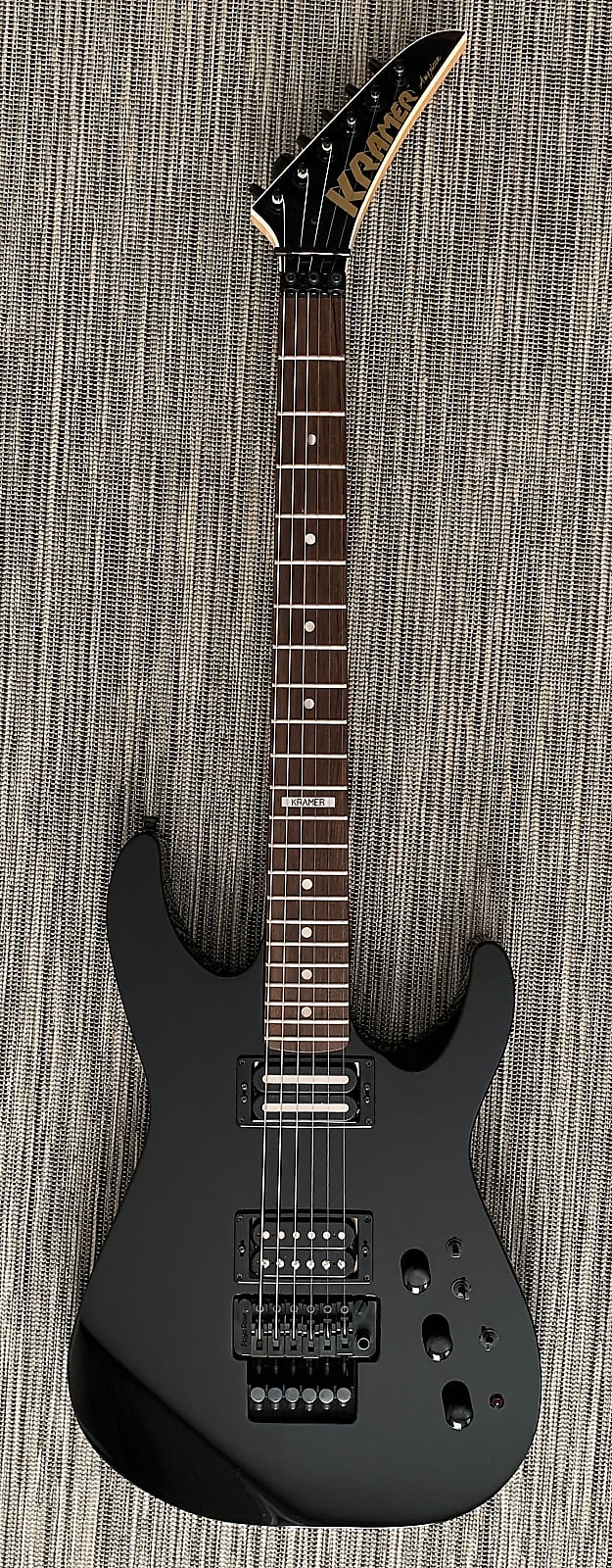 A Sustainer is basically a device for guitar that causes the strings to ring out infinitley, allowing for some uncharacteristically interesting sounds and incredibly long notes. A Sustainer is basically a device for guitar that causes the strings to ring out infinitley, allowing for some uncharacteristically interesting sounds and incredibly long notes.
However, in 1987, the first commercially known full six-string sustainer circuit was put on a production guitar by Kramer (left) - the Kramer Sustainer. The system seems like it was some kind of group effort between Floyd Rose (yep, that guy who made the locking tremolo system almost everyone uses), Schaller (Kramer's main parts company), and Kramer of course. The system consisted of a special pickup branded the "Floyd Rose Sustainer" pickup - which was a Schaller built pickup with internal windings for the "Driver" and external windings for the pickup part of it. The internal windings would be sent to the Sustainer control board (of which there are several revisions) when the neck pickup was off to induce vibrations in the strings of the guitar. However, it never caught on, probably because people had to still buy purpose-built guitars to have such a device. Not everyone wanted a pointy Superstrat.
What Sustainer Circuits Are, Do, and how They Work for the Layman. A Sustainer circuit on a electric guitar, is a circuit that uses a "reversed pickup" - otherwise known as a "driver", that "pushes" the strings into infinite movement until the player turns the device off. The movement of the strings triggers a harmonic or fundimental note depending on the direction/movement of the magnetic field triggering the strings - in relation to the bridge pickup. Traditionalists tend to start to ask the barriage of crazy sustain-related questions that make open-minded people like myself a bit irate...."Why not just get a higher mass bridge" "What kind of wood do you have in there? Why not some African Bubinga Wood instead of Plywood, ya know, real ToAnZ WoOdz!" "Why not just get a good tube amp, crank it to that (not even described) sweet spot, and then you'll have all the sustain you want". Arguing with guitarists is a lot like aruging with lamestreamer I.T. people, a lot of "common knowledge" rooted in popular OPINION passed off as FACT because some rich guy with hardly the skills to perform his job has a cult of personality and like E.F. Hutton, when he speaks, everyone listens, even if he's totally wrong. So here's my scienfically founded explaination of what a Sustainer is for, and why one would want one. First off, not everyone has the luxury of living in their own home in a neighborhood without an HOA who is okay with you cranking your Fender Twin Reverb or Bugera 333XL to 11 when you're not at work just to make crazy noises or record the unpredicatble, positionally-reliant harmonic feedback you're working with. While I understand such talk is almost always a catalyst to Political discussions by people who think somehow they'll be the next Bono (and through their music no less), the cold hard, solid, scientifically backed truths are....
The application of a sustainer device of this type, is to grant PREDICTABLE, CONTROLLABLE, and MUSICAL, use of sustain and harmonic feedback. That's it. It's not the same as Jimi Hendrix - it's something more nuanced - such as what Steve Vai does. Plus there are some things a sustainer CAN do that the classic high volume+close proximity to an amplifier CAN'T Do. For starters, you can use a sustainer with a CLEAN tone to create long runs of sustain and harmonic blooms without having distortion at all, you can use a clean tone, which can generate synthy textures, horn-like sounds, and generally, really expand the capabilities of a electric guitar in ways not well explored. You can also use it with synthesizer patches/sounds to allow you to care full melodic lines that sound nothing like a guitar - like synthesizers. These systems all typically work much the same way the player turns on the sustainer, a little amplifier inside the guitar is activated, the "Driver" is connected where the speaker would be, and creates magnetic pulses influenced by input from the Bridge Pickup of the guitar to generate harmonic or sustain-inducing feedback. The feedback results in either infinite sustain, or notes blooming into harmonics. That's basically it....see-flow-chart-below to explain the interaction between the player, amp, guitar, and sustainer circuit in very basic terms...  To explain - you pick the strings, the strings send a signal to the bridge pickup and the rest of the guitar's circuitry, which also feeds into the preamp for the sustainer, which amplifies the bridge pickup, sends it to the sustainer driver, which then, like a speaker, sends the audio signal through the coil, using the strings like a speaker "cone" of sorts, so the audio that comes in is then sent back INTO the strings, and then back into the bridge pickup where it came from, where it comes out of the amplifier, and continues to influence the string movement through the preamp/driver combo driving the guitar strings. It's basically a loop going on WHILE you're playuing with the sustainer on that keeps the sustain infinite. I'm not sure how much clearer I can be about this one. Indonesian Sustainer Systems So as it stands right now, there's two companies making sustainer systems for guitar that are more affordable to the masses, and both are based in Indonesia. iSUSTAINER and VEYZ Sustainer. 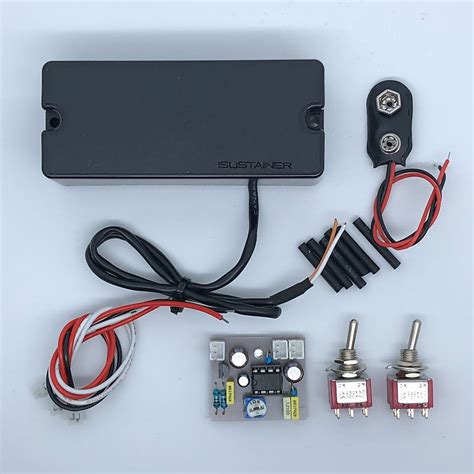



iSUSTAINER makes a handful of "2-mode" systems but seems to be slowly ramping up to more complex sustainer systems. This was the first system I bought, and it cost me around $75 total shipped from indonesia and took about a month to come in. At the time it seems they only had 4 systems - a 2 push/pull knob setup in single or humbucker format drivers, or a 2 switch system with single or humbucker sized drivers. None of their drivers double as a regular pickup, and the instructions show that the pickup selector is basically useless - unless you did what I did, which was the same as what Steve Vai tried with Flo a few times it seems. Currently they are expanding into fancier systems that do have pickups in them and three modes, and the prices reflect that. The older systems were between $69.99 all the way to about $90. The newer systems are hitting the $130+ bracket their competitor is now sitting in. 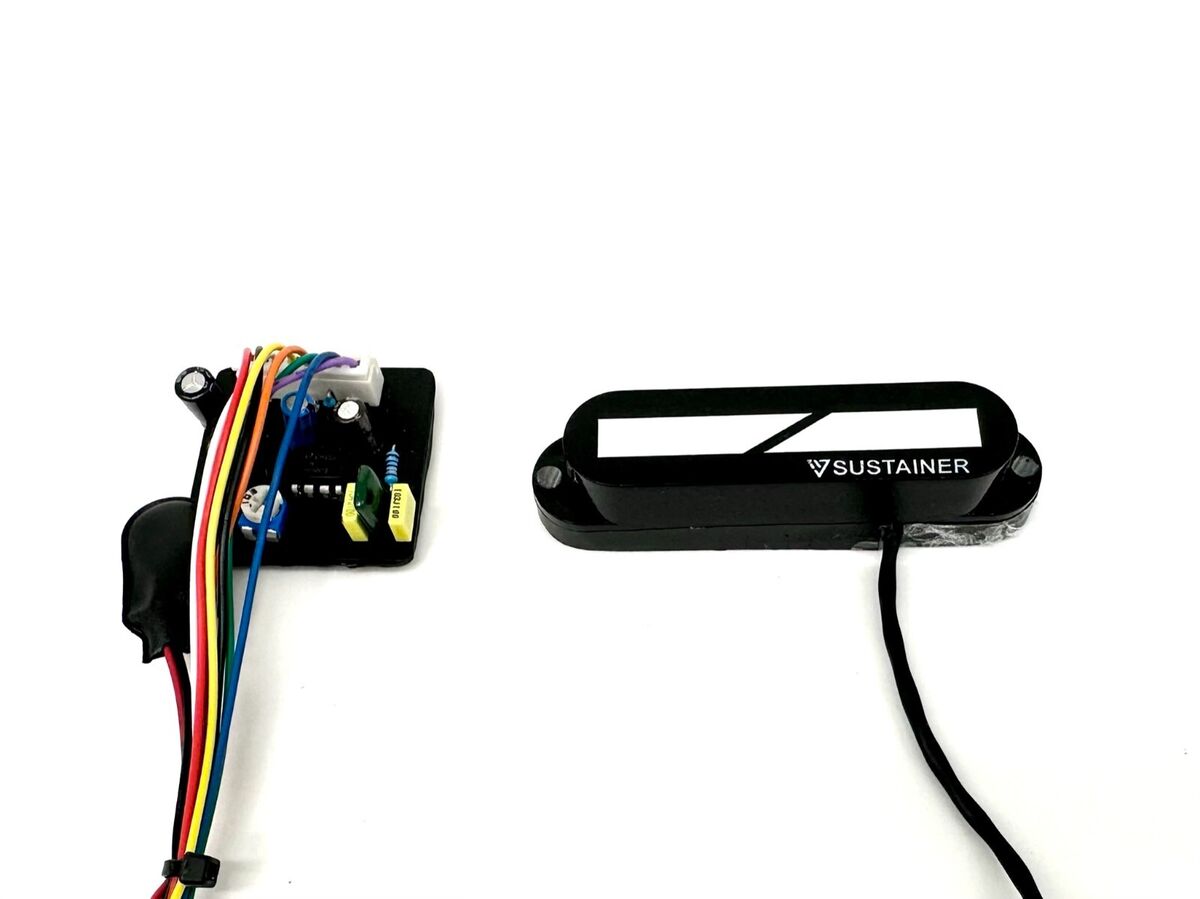

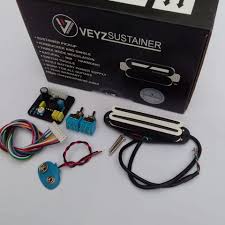
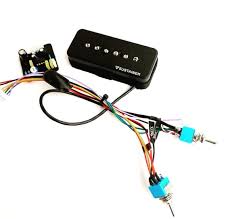
VEYZ Sustainer - VEYZ is better known by name and is seen on e-bay, Reverb, and Etsy. Their systems range from around $100 which I bought my first system from them for (with a discount from e-bay to get the price that low), all the way to almost $300. It seems VEYZ tries to copy the appearance of the bigger name brand systems, sort of like how Asian import companies recreate popular guitar models. They include models that look like the systems found in Vai's guitars, Sustainiac, Fernandez, and even some original units that just look like a regular humbucker pickup in varying styles ranging from a EMG blank-cover all the way to Gibson PAF style with a chrome cover on it. They also combine with a pickup, which explains the added cost, and have a wide range of colors outside the standard white/parchment/cream/black paradigm which we see with most plastic guitar products. Considering the cost, that's a minimal outlay compared to what it'd cost buying a $250.00 Fernandez system, or especially the big, expensive Sustainiac stuff, which is such a small fry operation that has a website that looks even more antiquated than mine does (lol). Not bashing any of the products, I've used a Sustainiac and it's a great system, it's just not financially feasable for someone who is wanting to try this out the first time, and is installing it in a $250 guitar, and is not making money playing music. Maybe if it could detect lost packets on an ethernet drop, I'd be willing to drop down more.Battle of the Indonesian Sustainers - Veyz vs. iSUSTAINER - the Website Version 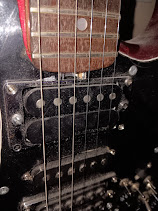
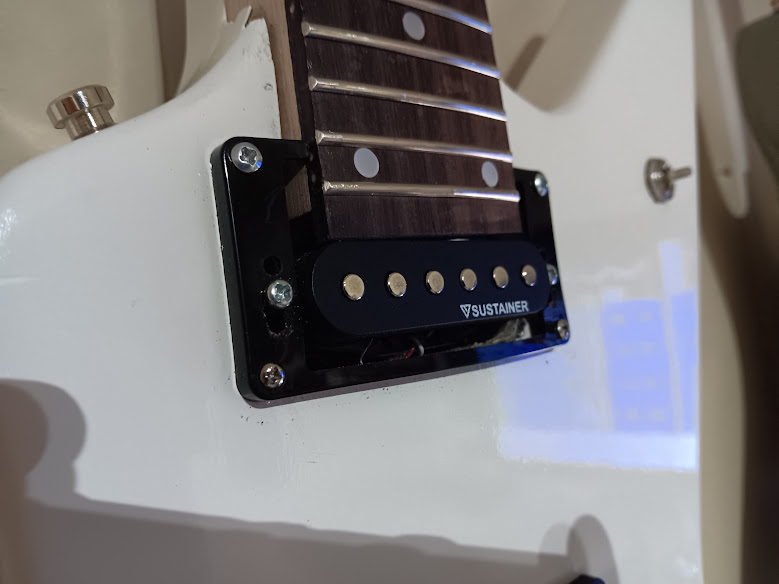
I selected two guitars for these, the first one being my 1985 Kramer Focus 3000 that has been semi-retired since about 2006, making casual "appearances" on BandLab, and had been recently refreshed with new pots and a hopped up bridge humbucker. The other guitar is my Explorer custom build - a 1984 Arbor Explorer copy body routed for a Strat Trem (and then tweaked by me to fit a Floyd Rose to), with a Yinfente 24 fret Explorer style neck with Floyd Rose R2, 43mm, locking nut shelf (bolt-on), and a Guitar Manaics high output humbucker pickup in the bridge. The reason I picked these two, is these are the kind of guitars outside-the-box of a Epiphone Les Paul Standard with a Licensed Floyd, or a Ibanez RX modded with a Licensed Floyd and setup to look like Steve Vai's EVO/FLO guitars...that someone might want to put a sustainer system like this into. Both sustainer units I picked were comparable units, and both units were also a good test of the difference between e-bay (Veyz) and Reverb (iSUSTAINER), how the companies handle orders, who they used for a courier, and how easily tracked stuff was. Purchasing, First Impressions, Pre-Installation Stuff
Let's start with the variation between all of their units - ALL of their units are named "TB-60" - so if you look what I used up, it's going to turn up as a TB-60. What you'll want to see is a single-coil sized driver, 2 toggles with PCBS on the bottom, and a small PCB about 1"x1/2" in size with visible traces. All of iSUSTAINER's units are advertised on a stark, white, background, and you won't see anything advertising their company except "Infineum Sustainer Products" on the lower corner of the listing on Reverb. The unit I have as of 4/2024 can be found here. They only come in one color - BLACK. Which for me is great since that's my favorite color for pickups if my quiver of axes isn't any indication. But it might put off people who are being far mroe creative with their guitars, but honestly, if you're putting that much work in the appearance, maybe paying more for the Veyz product might be more productive. As for social media/YouTube/etc. They do have a YouTube Channel which is pretty much the only place besides mine right now that covers their sustainer units. They apparently had a Facebook Page at one point, and a somewhat very mildly active Instagram account.
Watching the YouTube Videos about VEYZ is a mixed bag. One thing I noticed with a lot of the people complaining, was them asking for support. This goes hand-in-hand with my beliefs on purchasing products like this from over-seas, assume there is NO SUPPORT. The other thing is it seems a lot of people dove head-first into installing these without ever googling what needed to be done. I'm not passing any silly judgement on anyone's routing jobs, or anyone's actual attempts at installing this aside from the fact that a lot of people complained there was no instructions with the unit. After installing the iSUSTAINER installing this was a literal breeze because Veyz seems to have it all pre-laid-out for you. We will get more into STANDARD Sustainer type designs once I talk about designing my own units. While there's a wide variation in drivers, the general wiring for most of these seems to be the same, a molex connected wiring harness, attaching to a PCB that seems to hide what their circuitry is. And that molex provides links to the switches and battery jack that control the unit. They have official wiring diagrams it seems on their primary e-bay account shown with the products they are selling, but people have said some of these are a bit inaccurate. Most of these are sold with descriptions like "Active Pickup Sustainer 3-mode with Driver for Neck Position" or "Sustainiac Style Neck Pickup Three Mode". And all of what they have looks rather cool. All of their sustainer systems are shown pre-wired already, to indicate literally a almost "drop-in" (though with a Soldering Iron) type install if you have a guitar that has a pickguard on it like a Stratocaster or Ibanez RX/RG type product in the Steve Vai vein (which it seems most people who are into Vai or Schon are buying these). Choosing a system can be rather tricky for the newcomer. The unit I wound up going with was this one. It was a bit unclear whether this was a pickup as well or not, seems it's not, but that's actually great because I wanted to compare this with iSUSTAINER's unit and have a fair challenge between the two on quality of the sustainer unit's functionality. The way to tell if the Veyz unit you are looking at is a Sustainer only or a pickup, check to see how many leads are coming from the driver and if the driver is a humbucker or single sized driver. Single drivers like mine have 2 leads - white and red, while the Humbucker sized units have 2 shielded cables going to the driver package: one set for the actual pickup, the other set for the driver (red/white). Humbucker sized drivers can come with an accessory coil installed (hence why they are more expensive). I paid only $100 for my unit b/c of an e-bay offer. Typically Veyz costs between $150 and $300 - still cheaper than the Sustainiac or Fernandez units in some cases, but not as affordable as a basic sustainer driver/board setup from iSUSTAINER which is still around $70-80 for the most basic setups. Ordering, Communications, Shipping iSUSTAINER TB-60 - I ordered my unit off of Reverb in late November 2023 and it arrived about a month later in December. Ordering was a pretty simple process, same as any other Reverb transaction. There was no communication with the team at Infinity Guitar Industries about the unit or anything, just money sent, order shipped within a few days, and was shipped via China Post from Indonesia, and then arrived via USPS in a small 3"x3"x1.5" box wrapped in bubble wrap and a lot of tape. They were asking $65.00 for the unit, and I paid a total of $75.00 incl shipping/import/taxes/etc. VEYZ Sustainer - I ordered through one of their two sales pages, this one being "amsproduct.id". I got an offer from e-bay for $100 vs. the original $135 or so they were asking, for a total of $135.00 incl tax, shipping, and whatnot. It also seems Veyz, even when doing standard designs, is still doing "Built to Order" like Guitar MAX mentioned. Unlike other people, who probably have a lot of demands, I'm an easy guy to please, I just wanted the basic, black, single-coil style sustainer driver. They inquired about this in a message over e-bay's messaging system, all I replied was "black" and we were good to go. Shipping took about a week to occur, which was over Easter weekend 2024, but then took less than a WEEK to arrive. amsproduct/Veyz seems to use DHL for their deliveries and DHL...man, those guys are fast. Also a lot of communication regarding recieving the package with DHL including where to drop it off and who to sign for it (allowed for unsigned delivery at my apartment since I was at work). Wife brought it in and put it on my desk. Comparison - The comparison to me is, do you want less communication, wait longer, and less choice, or more communication, even if your needs are VERY basic, and surprisingly fast shipping? TBH, I would not kick either out of bed for the customer experience, both seem to do a good job, have effective enough communication through the ads to let you know what you are getting (even if Language barriers can be a little tricky - hey, remember, these guys live in INDONESIA not America, you're not going to get a guy whose got English as their first language - cut em' some slack). I can see how Veyz would rub some people the wrong way, especially Millennials and younger people, as it's a much older way to ordering a product from a specialist than younger people are used to in 2024. But this is kind-of how it was on the early internet, except getting such an item from Badung Indonesia in 1994 would have taken 3 months with no tracking whatsoever. So honestly, what you like is up to you. Each one was a trade off, uneasiness with iSUSTAINER because of 2-3 days to ship and long shipping, and uneasiness with VEYSZ because the reply I got to my simple order at first hit me a little like...."okay...what I am I getting into" - but instead of making some knee-jerk reaction most Americans would, I took a step back and said to myself "these guys are in another country and English is not their first language so they don't quite get the finer context of what my American ears hear - cut em' some slack, it's like me trying to talk actual Japanese". Packaging, Instructions, Parts Provided, Clarity of Pre-install iSUSTAINER TB-60 - Opening the box, you get separate bags with all the parts, a bag of about six or eight wires and a battery clip for a 9v battery, a small PCB under an inch in dimensions both ways, 2 toggle switches with their own silkscreened PCB's soldered to them, and then the driver itself which looked like an EMG Select style pickup without any naming or branding stamped into it. Both toggles are 2-way, one is an obvious phase reverse for the coil for the fundimental and harmonic modes, and the other the on/off toggle. There's also an instruction sheet inside the box that provides some pretty basic instructions. VEYZ Sustainer - The Veyz Sustainer unit came in a branded box with "YudaVeyz Sustainer" printed on it and a bunch of flags, and pictures of the unit in question. The unit came with the entire-harness-pre-wired. Basically, the driver unit, a Fender-style single coil shaped unit with white and red wires, was wired into the Fundimental/Harmonic mode switch (basically a DPDT phase switch), and then the other parts of the harness for power, neck pickup, and what have you, wired into the power switch. all of the wires neatley tucked together with a single cable tie. There was a cricut "Veyz" sticker inside the box, which looked so cool I actually put it on the guitar where the Floyd Rose bridge will stop - and it's shaping goes well with the Gibson Explorer body shape. Actual Installation Process and their Differences
One thing that will be different, is that I chose to put a singel coil - in this case a Samick X13 style single coil, right next to the Sustainer on a pair of plastic "ears" that allow it to be adjusted up and down like a regular humbucker pickup. This is basically the same setup as Steve Vai's FLO setup in some cases. And it works great, except this, being my first sustainer install, meant I need to be careful using this device on this guitar so as not to shatter windows and blow out eardrums. That said, I have some DPDT switches on order for the neck and middle pcikups so I can sever the power-connection to the sustainer when I turn on the neck or middle pickups in a live situation. I'm copying this idea over to my Vester Concert II build as well. iSUSTAINER also leaves their boards unobscured so you can see the schematic, and if the board ever has a problem, you can repair it yourself. So serious pro to iSUSTAINER for allowing people who are competant in electronics to see their work in the circuit. That said, their circuit is VERY Simple looking compared to VEYZ circuit. Testing the installation took about an hour, mostly me setting the gain, which I just set to maximum anyway. The biggest struggle was the 9volt battery was already pretty used up that I used that go around, so the sustainer was not nearly as vibrant as it would turn out to be during play-testing and eventual use.
Gain Adjustment and First Impressions Post-Install iSUSTAINER - The iSUSTAINER comes pre-shipped with the gain trim pot on the board set to minimum gain. So first off, I felt like I'd been had for a moment when it would not do anything despite being installed per the instructions. It took me a few minutes of finagling and I started to get an output from it. Of course, part of this weakness was that the battery I was using was not exactly what you'd call "new" - it had about 5vdc of 9vdc left on it. Eventually I got it sorted out and could pull full sustain from it. It REALLY pepped up when I put in a fresh battery though. I used Duracell 9volt batteries on it to start out with (might try the Energizer Lithium batteries next), and it seemed to really start bringing in some power. At this point, I was quite impressed. I had to adjust the trimpot for maximum gain though, which means I get a little bit of distortion in the background. That's fine. An interesting twist is I found out that I can use the middle pickup of the Kramer with the iSUSTAINER too and the whine does not translate over when playing through my Bugera 333XL. Which is quite surprising. This means I can maybe do some synth-pad type things with chords using this device. I noticed that the stiff-build of the Kramer paired with the Sustainer causes the whole guitar to vibrate on some notes. It seems very alive guitars REALLY like this thing.
Once I finally got strings on, it was immediatley obvious this thing was a bit more powerful than the iSUSTAINER is. For starters, one mode lets the sustainer board shreik like a banshee as the gain trimpot had been set about half-way by default, while the other setting on the phase switch was quiet (the way that fundimental/harmonic modes work - is the driver's positive and negative connections are reversed by a phase switch exactly like you'd use on an in-phase/out-of-phase pickup switch on a regular pickup). Adjusting the trim pot revealed, I think this is a Push-Pull type arrangement, where balancing the trimpot between the two positions yields the best result, as opposed to the iSUSTAINER that seems to like having it's gain cranked full on. It seems right off the bat the VEYZ is a bit more oriented toward Feedback type blooming harmonics, where the iSUSTAINER is more oriented to actual sustained notes, as it almost seems like I have 2 different harmonic modes, one with higher harmonics, and one with lower harmonics. This in itself is really cool. However, getting that trimpot balanced right is tricky. Too much and it's squealtown, too little and you don't get as much work out of it. That said, the VEYZ has a very interesting switching scheme per most internet schematics - basically, it repurposes your pickup selector to use the disabled neck position pickup selection as a "mixed mode" switch. So bridge = natural, neck = mixed. Cool. Honestly, my install seems to have boosted the versitility somewhat, because my eventual intent with this Explorer build is to maybe hide a "Five Dolla Make it Holla'" pickup somewhere in the neck position either next to, or even UNDER the sustainer unit. Honestly, I'm having a hard time telling which one I like better. On one hand, the iSUSTAINER seems more oriented to holding fundimentals better, and the harmonic mode is a little...uh...on the weak side on initial notice, while the VEYZ seems to be better at pulling out all sorts of crazy harmonics from the strings that sound cool, but it also seems to color the sound quite a bit.How Well the Systems Work in general Like I said, the VEYZ is more harmonic rich, while the iSUSTAINER is more of a fundimental mode machine it seems.Both units rely on strong batteries for the job. I'm thinking about trying Energizer Lithium batteries next on these to see if that will give them a little more oomph. That said, I've had the unit in the Kramer about six months, and the Veyz have both seen heavy use since I got them and they're still not dry yet....so we shall see. iSUSTAINER - The iSUSTAINER is it's strongest in fundimental mode, with quite a few dead spots up and down the neck. That said, it seems to have a lot more live areas in this mode than the VEYZ does. I found slapping the driver right up near the strings helps the most. During an "Acoustic Test" I can get some rather loud notes on the upper end of the neck, but there's no rattle, so this unit is decently powered, but not over-powered. IT seems iSUSTAINER's Op-Amp is a little more balanced. In Harmonic mode, it seems to do better affecting the lower three strings the most, and some of the "G" String. The experience kind of reminds me of being 12-13ish in my childhood livingroom at 9pm on a Tuesday making harmonic feedback with the same guitar through my Peavey Rage 158 amplifier, lol, though far more controllable. Flipping from Fundimental to Harmonic mode with the iSUSTAINER can make/break the situation depending on the string and where/if it's fretted or not. Why would one want to do this? Maybe you wanted to sustain a fundimental note and then flick the switch to throw the sustainer into "harmonic" mode quick to emulate sort of a "feedback bloom" of sorts. This switchover resulted usually in the note dying off in the end and not "blooming" in most cases. The other way around though, the harmonic mode note would transfer back to fundimental mode pretty easily. Hence my comment on this being a "Fundimental Machine" because it really likes to sustain the actual note really well. This was very useful with synth patches on the Line6 HD500 but to a point since there is a element of "Decay" to the note that leads the synth patch to thinking the guitar has gone up an octave....leading to some neato Portamento effects. Think right before the bass kicks in on Loverboy's "Turn Me Loose", but faster. Using the whammy bar to help some more "Cranky" notes really makes a difference, so having a guitar with a vibrato can be of great benefit. However, it's easy to forget that you have this sustainer on as there is no safeguard. I'm currently developing new "failsafe" wiring diagrams for the iSUSTAINER TB-60's installation into various guitar wiring scenarios, since the company only seems to have ONE installation method in their folded printed manual. VEYZ - The Veyz Sustainer took a lot of tweaking of the trim-pot to get it in the "sweet spot". The amp and driver on this are a lot more powerful than the iSUSTAINER unit is, but they are also more expensive, and somewhat trickier to setup. I think what Veyz was going for here, was a solution to compete on a lower price point with the more expensive and better known Sustainer products by Sustainiac and Fernandez. Hence the wiring harness that wires in differently. I found the sweet spot on my custom single-humbucker Explorer build was about a little right of halfway with the trimpot toward the bottom. I would turn it left until it's just about to shriek. Once there, I found the sustainer works great in what I think should be fundimental mode, though I still get some harmonics in fundimental mode, which is kind of wild. I do find depending on the trim pot leve, the VEYZ unit can alter your tone a little bit. It kinda' gave the guitar a "Dean Machine"-like Howl....like I had resonance slots in the neck, when in Natural Mode....sort of a half-cocked "Wah" kind of tone. Kinda' cool. This effect would be kicked back by engaging middle-position, which gave the same two modes, but they behaved a tad differently because now this adds my 500K Tone knob into the mix for the neck pickup, which made for some interesting "muffled" kidn of sounds that were almost synthy. Neck position - which I only discovered after re-reading some of VEYz posts on e-bay, was the "mixed" mode. This mode gave me a mix of both. I'll add more on this as I experiment more with the guitar's circuitry. I'll say this, the VEYZ unit is REALLY strong....so strong that when I push notes down, I can make the strings rattle against the fretboard of the guitar rather easily, to the point it almost sounds like a musical water-hammer when playing low strings on high frets....which is AWESOME. Seriously, sounds like my old apartment when the neighbor would flush his toilet in the middle of the night.....I can think of several crazy musical uses for this effect. It will pick up a bit more easily than the iSUSTAINER, but is considerably more cranky about it's mode. It makes me think I should maybe remove the tone control and put in a "sensitivity" knob instead....or wire the trimpot to that knob for some wide varitation. Either way, the VEYZ has a bit more strength and options, but learning to control it well might be more daunting for beginners to using this kind of technology. Final Assessment and Quick-Reference Table
VEYZ vs. iSUSTAINER COMPARISON CHART
Designing my Own Sustainers & Drivers An alternative long before VEYZ and iSUSTAINER came along was to make your own sustainer. Because, let's be honest, you're paying a premium for a pretty inexpensive lot of parts. It seems the biggest challenge with these systems is making something efficient enough that it does not eat 9 volts like candy, but also making something that has a strong enough pull to make the strings move. Currently I'm working this out with a custom 8 ohm driver I made using a Harmony H802 Pickup (the bobbins are 100% the correct height) and some neodymium Hard Drive magnets - and a breadboard. The current in progress design is an LM386 based op-amp that's pretty simple, but seems effective. However, I'm starting to pick up a few things. Seems, based on my experiences with the Veyz preamp, the amplifier inside the guitar SHOULD distort, after all, thats how you get feedback in the first place, and all you are really doing, is installing a miniature amplifier inside your guitar, and using it to drive the strings. It needs to be powerful enough to be it's own amp, so an 8 ohm speaker is being used to test my amplifier before I build it. Seems this circuit is working best using the Ataricaster's built in distortion unit to distort...so I might make a SECOND op-amp that uses the Sustainer/Driver with the LM386 at reduced voltage to induce distortion. Seems with this combination, I get a really LOUD, thick, distorted sound that drives the strings with a 10.5K stacked humbucker well. I'm planning though, to use a DIFFERENT driver that's just a bar magnet of neodymium with the coil wrapped directly around it - Danelectro style - and then sealing it inside a home-made casing with Epoxy Resin so it doesn't even look like a pickup. Alternative Wiring Diagrams for iSUSTAINER PRODUCTS While they do provide diagrams for most of the basic guitar products out there - they have left out some of the less common models to throw one of these in (ie Jaguars, Mustangs, etc.) - (right click to view diagram in full size).
3 Pickup (HSH-Route) Wiring w/ individual Toggle Switches & Hearing Protection
3 Pickup SSH (HSH Routing) w/ individual toggles & Push/Pull Pots w/o Hearing Protection Alternative Wiring Diagrams for VEYZ PRODUCTS While they do provide diagrams for most of the basic guitar products out there - they have left out some of the less common models to throw one of these in (ie Jaguars, Mustangs, etc.)
3 Pickup SSH (HSH Routing) w/ individual toggles & Push/Pull Pots w/o Hearing Protection |